![]()
![]()
![]()
Use LEFT and RIGHT arrow keys to navigate between flashcards;
Use UP and DOWN arrow keys to flip the card;
H to show hint;
A reads text to speech;
73 Cards in this Set
- Front
- Back
|
Genesha |
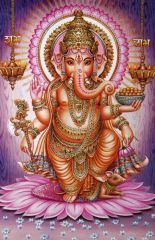
The god of good luck and good fortune. His nosegives good luck, you rub it. There are many sacred texts, there’s not one wayto follow the religion. Hindu isn’t even one word they would describethemselves for some people. Hinduism is a foreign word, who experienceddifferent things in India. So, they labeled the people being religious as‘Hinduism.’ |
|
|
Sindhu |
People who were in Sindhu Valley were practicing the same religious routines, so they are sometimes named Sindhu by foreigners. |
|
|
Sanatana Dharma |
The actual people who practice Hinduism call it Santana Dharma. Sanatana means everlasting. Dharma means truth.
|
|
|
Vegetarianism in Hinduism |
The cow is sacred in Hinduism. It produces milk,of all things that are pure or impure, things that produce milk are pure. It is the preferred diet if you are Hindu, is vegetarian.
All of life is sacred. Do as little damage tothe world provided.
|
|
|
Krishna
|
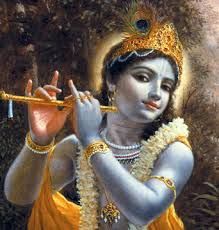
God of compassion. Hangs-out with cows because he has an interest in cow herders. He is attracted to the female-herders. (Yes this god is male) |
|
|
Reincarnation in Hinduism
|
You are re-fleshed into life. Hindu makes a circle in life as opposed to a straight line in Christianity. You have many lives to get it right in Hinduism. Your spiritual self gets reincarnated. Determining how you live your life now will form you into different classes.
Atman:“Your soul/spiritual self” |
|
|
Caste System
|
if you are a lower social group and you were a good person in that caste the next time around it can be a higher caste. You can be reincarnated into a lower species. There’s a whole chain of life where you can move up and down based off how you live your life now. |
|
|
Karma and Dharma
|
Everyone has their "Dharma". Dharma here means truth. Which is your duty. Everyone has a duty/dharma that is designated to their caste system. (Ex: A dog being the best dog it can be). You gain Karma when you follow your Dharma well. |
|
|
Sari
|
Indian social life is conservative. Women are usually covered up largely. So, in Hinduism you have male and female deity’s. You do not see or touch women unless you have a special relationship with a woman in India. The goddesses are usually topless.
|
|
|
Khajurahao
|
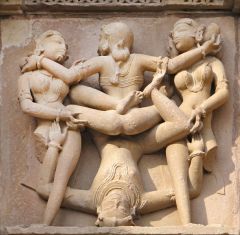
Scandalous goddess. |
|
|
Raja Yoga |
In the west, it’s an exercise. In Hinduism they have that too, which is there to calm your mind. To get you to a deeper level of consciousness. Your mind is like a monkey as Cain points out. Ex: Need to calm your mind on 8 counts. |
|
|
Old Trimurti |
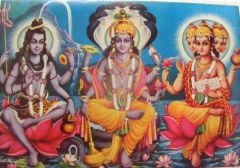
Three particular gods. The first is Brahma.
Brahma: The creator god. Why is there something rather than nothing, the answer in Hinduism is Brahma created it. Things come to be, then cease to be. This is due to Shiva.
Shiva: Shiva brings life to an end. Shiva dances in the ring of fire. She’s not just destruction, but she re-births life essentially by ending it.
Vishnu: The god that sustains life in between life and death, between Brahma/Shiva. Vishnu can manifest himself as Jesus of Nazareth or Buddha. |
|
|
NewTrimurti |
NewTrimurti: Vishnu and Shiva, but then you have the ‘Goddess’ Shakti. Brahma has fallen out of frequent familiarity.
Shakti: More temples dedicated to the goddess.
|
|
|
Shakti (more info and how gods move) |
Gods do not stay put, they can re-form into another being. Such as another god and another human. Ex: Shakti can re-form into Durga (god who fights evil in the world).
To illustrate this. When you see a god and it's blue it’s automatically Krishna. So if Vishnu was blue, then he was in the form of Krishna. |
|
|
Introducing Siddhartha Gautama and Buddhism in Hinduism
|
Hinduists liked the idea of the Buddha and said it was another form of Vishnu. Hinduism basically absorbed Buddhism when they competed. |
|
|
Code/Law of Manu |
The caste system comes from this scripture. There is a man named Manu, the divisions of his body makes the caste system. The people coming from his head is the highest caste. These people are called Brahmins. |
|
|
Brahmins |
(Highest caste) Scholars,professors, priests, these are occupations that are identified with the Brahmin caste.
|
|
|
Kshatriyas |
(Second highest caste) The people who come from Manu’s shoulders. Government officials, attorneys.
|
|
|
Vaisyas |
(Third caste) Business man, merchants, farmers |
|
|
Shudras |
(Fourth caste down)
From the feet of Manu. Factory workers, manual laborers, and persons who would work outside your class.
|
|
|
Shudras |
From the feet of Manu. Factory workers, manual laborers, and persons who would workoutside your class.
In conclusion. These various castes have a moral duty to follow. This is called their Dharma. It’s more demanding duties in the higher castes than the lower castes. Ex: Vegetarian is required for higher castes.
|
|
|
Brahma vs Brahmin |
Brahma is the god of creation. Brahmins = the highest caste. |
|
|
Untouchables:” or Outcasts |
They do the other jobs where they are too low to do the tasks the other castes are willing to do. Ex: Garbage men. Barbers. Dealing with death in jobs or dirtyjobs. Outcasts come from people who marry an outcaste, therefore your children become outcastes. In wrong settings, parents may kill their children for marrying the wrong castes. More permitted in an urban area. |
|
|
The four stages of life as a man |
-Student - Householder - Forest Dweller (moving yourself away from physical kinds of pleasures of life) -Sunnyasin (Sahu) totally renounced materialistic things. |
|
|
Guru |
(meaning teacher) some of the most highly respected of a person that exhibits the traits of a god or goddess. Characteristics of wisdom, spiritual maturity, etc.
|
|
|
Vedas |
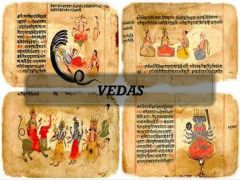
OldestHindu scriptures out there. They consist of rituals, hymns, sacrificial rights/ceremonies. Not all Hindu’s subscribe to them, but they know of them.
|
|
|
Bhagavad-Gita: |
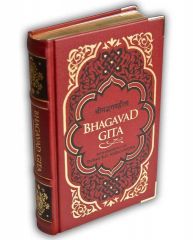
The most popular scriptures in Hindu. Story of a military person. The main figureis a man named Arjuna, he would be in the Kshatriyas caste. He’s preparing to go into battle into the valley below. He’s about to fight his relative. The issue is his caste duty is that he’s trained to kill and prepared to kill. when the situation calls for it you must kill. However, in Hinduism the chief moral value is non-violence. (In Christianity it is love) He’s in a chariot and dwelling on what to do. Dharma or Ahimsa. The driver says you have to do your caste duty. The people you kill, you’re killing their body, but you’re not killing their spiritual self. (Also known as their Otman). So, if Arjuna chooses to fulfill caste duty, it’s okay because they will reincarnate. Although, the chariot driver is not mortal; he is Krishna in a chariot driverform. So this makes it divine advice to Arjuna. The message is everyone needs to do their caste duty. Do your Dharma. It feels restrictive but there’s no pressure. |
|
|
Ahimsa |
The moral principal for non-violence. (Hindus increase us decreasing violence in the world, which could be not eating meat, not killing plants, no violence. Live causing no injury. Minimize it.) |
|
|
Ramayana |
One scripture story. Rama = individual yana = story. This story gets acted out in movies all the time. Rama is the protagonist, the evil figure is Ravan. The love interest is Sita, and the humor figure is a monkey named Hanuman. Rama who seems to be mortal he is the god Vishnu. He falls in love with SIta. A human story is happening but a theological story is happening as well.
|
|
|
The spiritual goal of Hinduism |
- Human Problem (X) Out of ignorance, we wrongly attach ourselves to physical reality; forgetting that there is spiritual reality which is more important. We forget about Brahman and Otman. Every religion sees a problem out there, all is not right in the world, what’s not right in people, etc. In Hinduism, it’s ignorance. We wrongly attach ourselves to material things, because we believe those things will give us ultimate happiness and satisfaction. Everything out there no matter if it’s human or an animal, has some kind of spiritual essence in them (Your Otman). Brahman (not Brahma the god, not Brahmin the highest caste): it’s a world soul, a spiritual reality that is in everything. Brahman is not a god, Hindus do not pray to Brahman. This is the Reality you should pay attention to, not materialism. -
Spiritual Goal: There’s an aspiration people try to move in the direction of. In Hinduism it’s called Moksha: Mokshahas two dimensions to it.
|
|
|
Moksha |
Moksha has two dimensions to it.
1) Liberation from attachment. Samsara: Freedom from the cycle of birth, life, death, and rebirth.
2) Reunion, at one with, the world’s soul Brahma. Your Otman becomes a part of Brahma. The individual drops of waters are Otmans that go to the ocean which is your Brahma. Physical reality is not worthless than spiritual reality, it’s just worth, less.
|
|
|
Human Tecniques/Human Actions |
Followers can engage in help to move them along the path of the spiritual goal.
|
|
|
Divine Help |
Is there any divine help that assist us in moving towards a spiritual goal? Yes. 330 million gods that can be appealed to for assistance in the journey. There are four. Called The 4 Margas.
|
|
|
Jhana Marga (Yoga)
|
The way of reason, the way or rationality, the mind. What gives your life meaning and what doesn’t. You can analyze the things that are suggested whether if this thing gives your life meaning vs. no meaning. The materialistic things do not give your life meaning, they just suggest they do. Real meanings are friendships, and family.
|
|
|
Raja Marga |
Combines physical postures and breathing control quiets your mind and penetrates you to a deeper level of consciousness.
|
|
|
Karma Marga |
Normally Karma is the mechanism that your Otman is going to in the next life. This Karma means work. Work is done for that service, not for a means to get money. What if work was an end in itself. (Think of Cain referring to having a job you love)
|
|
|
Bhakti Marga |
The way of the heart. Taking one of the gods to who you feel especially connected, and you try to imitate the positive qualities of that deity and bringing them into the world.
|
|
|
The Four Noble Truths |
- Life is suffering -Suffering is caused by desire - If you eliminate desire, you eliminate suffering. Getting rid of all desire is when you reach Nirvana. Eliminate desire by following the eightfold path. |
|
|
The Eightfold Path (KASB AND LEMA) |
(Right) KNOWLEDGE: Recognition that the four noble truths, are true. Assurance, confidence, and faith in it. ASPIRATION: Let’s analyze our motives, and intentions.
SPEECH: No lying, no slander, no swearing, and no gossiping. BEHAVIOR: No lying, no stealing, no murder, no drinking of intoxicating beverages.
LIVELIHOOD: Choosing that occupation or profession for which you are best suited. EFFORT: Avoid evil, do good. MINDFULNESS: Being aware, being alert. Be conscious. ABSORPTION: Being so thoroughly mindful that you don’t have to think about it, it’s just become a habit. |
|
|
Tanha |
Buddhist word for desire, meaning don’t crave something. A fire that burns inside of you. You're never satisfied. Eliminate Tanha, eliminate suffering. Attachment due to ignorance. |
|
|
Dukkha |
Buddhist word for suffering, due to Tanha |
|
|
Siddhartha Gautama (Gotama) "The Buddha" |
“The Buddha”,it’s just like Jesus the Messiah. He was the all compassionate one. 563 BC- 483 BC***Born in Nepal his father Raja was a regional King, born Hindu in caste Kshatriya(second caste)
Predicted Siddhartha would be a famous ruler to unite India or that he’ll be a spiritual leader. His father wanted him to be a ruler so he kept him from seeing any suffering or pain. Sid marries Yashodhara, has a son Rahula
Siddhartha ventures past palace wall accompanied by a friend and sees 4 things that show suffering
1. Sick man-never seen illness before 2. Seniorcitizen 3. Corpse 4. Wandering begging Hindu monk(Sadhu) with calmness and Siddhartha is confused After Siddhartha sees the four sights he leaves everything behind including his wife and son, known as “The Night of the Great Renunciation”
Lives in Asceticism (is a lifestyle characterized by abstinence from worldly pleasures) for 6 years until one night he sits under Bodhi tree and says he will not get up until the "answer” comes. The answer comes and he says “I am not a God, or prophet; I am awake” from then on he is known as Buddha. (The enlightened one) answer he gets is the four noble truths |
|
|
Nirvana |
-Distinguishing of all desire. No more reincarnation. A blissful state. You have to experience it to know. (When Siddhartha becomes enlightened, hebecomes Buddha – which means the enlightened one, or awake). ------Siddhartha said “I’m awake” when asked if he was a profit or a god, this is the moment he turned into Buddha. |
|
|
Sunnyasin (sadhu): |
stages in a man’s life. First you’re a student, then you’re a householder, then you’re a forest dweller, and then a sadhu (sunnyasin, wondering begging monk) |
|
|
Karuna (Compassion) |
Chief Buddhist Virtue
|
|
|
What are the different ways of concieving reality that are displayed in the East? (Hinduism) |
There is physical reality and spiritual reality. Physical reality is not totally worthless but is "worth-less" than spiritual reality. Our senses put us in touch with physical reality and our minds put us in touch with spiritual reality. “Brahman” is the Hindu term for spiritual reality and Brahman is within everything and it is in the form of an “Atman”, or soul. Everything has an Otman, even plants, animals, and humans. Brahman does not do anything, it is just a thing. Spiritual reality is most important because it is eternal and does not perish, even through reincarnation. |
|
|
On what points concerning "the way things are" do Eastern and Eestern religions disagree? |
Monotheism vs. Polytheism Linear time vs. cyclic time (reincarnation) Westerners think of Eastern religion as more of a philosophy of life and Easterners prefer philosophies of life over religion and think of religion as superstitions bullet; |
|
|
Some other Hindu gods? |
Durga- great goddess, beautiful women with a gentle face but ten arms that hold weapons to banish demons, she rides a lion
Kali- great goddess in a fierce form, dripping in blood,, carrying a sword, and wearing a necklace of skulls Siva- he is creator, preserver, destroyer, personal Lord, friends, and primal soul. He swallows the poison that threatens the whole world with darkness and neutralizes the poison by the power of meditation Parvati- Siva’s spouse, through their union cosmic energy flows freely seeding and liberating the universe |
|
|
What cultural and religious forces came together in ancient India to form Hinduism, a world religion which has no individual founder?
|
People from outside of India, invaded India and mixed it up with many different indigenous people and this came to be Hinduism. This is called the Aryan Invasion Theory. Aryan people (foreigners) and Dravidians (indigenous people) mixed together and formed Hinduism. |
|
|
What is the chief sin for Hindus and why? |
Attachment to physical reality out of ignorance
Why is this the chief sin? This is the chief sin because Hinduism really focuses not being attached to material things and that you have to be unattached to achieve Moksha. |
|
|
Distinguish among these terms: Brahma, Brahman, Brahmin,& Brahmanas. |
Brahma- Hindu creator god
Brahman- spiritual reality, ultimate principle in Hinduism
Brahmin- a priest or member of the priestly caste in Hinduism
Brahmanas- portion of Hindu Vedas concerting rituals |
|
|
More about the Hindu Scriptures |
Vedas- books of knowledge, oldest scriptures 2 sections Upanishads- philosophical treatment Brahmanas- liturgy, hymns, prayers for worship Bhagavad: Gita- stories Central figure: Arjuna Trained to kill but Hindu virtue is no violence so he is struck Was told to do duty but override peace Vishnu=Krishna= charier driver Always do your duty to your cast system Ramayana Rama (hero) → God manifestation of Vishnu Sita→ Ramayana love interest Raven → evil Monkey - Hanuman (Comedy) |
|
|
Where did the castes come from originally in Hindumyth? |
According the Rig Veda, the ancient Hindu book, the primal man - Purush - destroyed himself to create a human society. The different Varnas were created from different parts of his body. The Brahmans were created from his head; the Kshatrias from his hands; the Vaishias from his thighs and the Sudras from his feet. The Varna hierarchy is determined by the descending order of the different organs from which the Varnas were created. |
|
|
What is the significance of the caste system? |
The caste system is significant because Hinduism’s strong emphasis on social duties and sacrifice of individual desires for the sake of social order. It’s purpose is to uplift people from worldly concerns and encourage them to behave according to higher law. This is positive because it does continue traditions, divide labor, maintain lineage purity, and regulates social order and sacred law (dharma). The negative part is that it is unfair, there are people being treated as less than humans, it’s an instrument of oppression, it keeps people from living life as they want and marrying who they love. |
|
|
Puja |
Worship that is usually carried out by brahmin priests. |
|
|
What was Ghandi's perspective on the caste system and in light of him, what is ahmisa?
|
Ghandi was an opponent of the caste system because it created social injustice between caste levels. He also renamed the “untouchable” class to the “harijans,” which means “the children of God.” Ahimsa is non violence and it is the chief moral virtue. This is connected to Ghandi because he fought violence with nonviolence For Hinduism, what isthe spiritual problem, what is the spiritual |
|
|
Why do you think that Hinduism is regarded as one of theworld’s most tolerant religions (though there have been instances in whichfanatical Hindus have been violent toward people of other faiths? |
This is because Hindu people do not believe in a hell or that non-Hindus are going to hell and they also do not believe in converting religions or trying to get people to convert to Hinduism. They also believe that all religions lead to the same divine truth. They also are strong believers in nonviolence, peace, fairness, and justice. |
|
|
Swadhyaya Movement |
Many people in India who are beneficiaries of asilent social revolution based on the principles of the ancient Hinduscriptures |
|
|
Dr. Karan Singh
|
one of the world’s most respected spokesmen ofHinduism; turned over his entire princely inheritance to the service of thepeople of India and converted his palace into a museum and library |
|
|
When was Siddhartha born and passed
|
563 BC- 483 BC |
|
|
Sangha |
Sangha- monastic order that developed from the Buddha’s early disciples. Accepted people from all castes and levels of societyso believe |
|
|
What are the three jewels(treasures)- the “Triple Gem”- of Buddhism? |
Each one begins with "I take my refuge in" (I identify with..) 1. Buddha 2. Dharma (teachings of Buddha) in Hinduism it means duty. 3. Sangha (Buddhist community) closest thing to a creed in Buddhism Theravada- includes only monks and nuns Mahayana and Vajrayana- includes all buddhists |
|
|
Bodhisattvas |
a person who isable to reach nirvana but delays doing so out of compassion in order to savesuffering beings. |
|
|
Asoka in Buddhism |
Asoka ruled a couple centuriesafter Buddha. Under his rule there was war and lots of people died. Asokadecided to become a Buddhist and end violence. His following of Buddhism gaveit more popularity. |
|
|
Theravada Buddhism |
No transcendent help. You can only blameyourself for not reaching nirvana. (Buddha is only inspiration, 20% ofBuddhists) The Buddha is the enlightened one whom we imitate. |
|
|
Mahayana Buddhism |
Buddha is God, a savior Buddha can help youachieve your goals. (Buddha is perspiration) You must offer him things. The allcompassionate one. The one who’s taken a vow. Believes in 33 heavens. |
|
|
Vajrayana Buddhism |
Known as Tibetan Buddhism, Buddhism ramped up.Dalai Lama. Zen Buddhism. Attempts to return to the idea of self-salvation.Tries to go back to the origin. |
|
|
Who is His Holiness the DalaiLama, and what values/virtues from Buddhism does he exemplify in his life? |

His holiness the Dalai Lama showscompassion to everyone, a value of Buddhism. He gives and helps others which isalso important to Buddhism. But also shows he does not have a lot of desire forhimself. |
|
|
Anatman
|
The principle in Buddhism that says there is no eternal self.
|
|
|
Four Sights
|
1) Sick man- never seen illness before 2) Senior citizen 3) Corpse 4)Wandering begging Hindu monk(Sadhu) with calmness and Siddhartha is confusedAfter Siddhartha sees the foursights he leaves everything behind including his wife and son, known as “TheNight of the Great Renunciation” |
|
|
Anatman |
There is no eternal self. You have five dimensions to you, and when you die they come a part and there is no more you. Based on your spiritual journey, 5 more aggregates comes together to form you in your new life. (In Hinduism your Otman survives your death) |
|
|
Tripitaka / Jatakas |
“Three Baskets” or another name for the ancientcanon which is an authoritative collection of writings. The Buddhist scriptures. Basket 1 for monks, Basket 2 for Buddha, Basket 3 for ideology. Jatakas: Stories of the birth of the Buddha. Buddhist do not have a caste system. |
|
|
The 3 Branches
|
Theravada Buddhism- oldest form of Buddhism. no transcendent help. You can only blame yourself for not reaching nirvana. (Buddha is only inspiration, 20% of Buddhists) The Buddha is the enlightened one whom we imitate. Not everyone is on "the boat", they spend time in the monasteries. Mahayana Buddhism- Majority. Means the big boat. Buddha is God, a savior Buddha can help you achieve your goals. (Buddha is perspiration) You must offer him things. The all compassionate one. The one who’s taken a vow. Believes in 33 heavens. Has monks and nuns, everyone is on the boat. Zen: A group of Mahayanas who want to return to Theravada ways. Koans (reasons and sayings that get you beyond reason) Vajrayana Buddhism- Known as Tibetan Buddhism, Buddhism ramped up. Dalai Lama. Zen Buddhism. Attempts to return to the idea of self-salvation. Tries to go back to the origin. |

